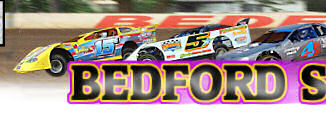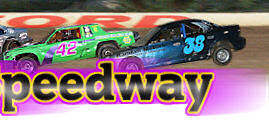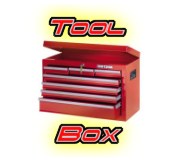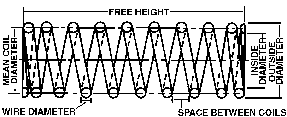  |


COIL SPRING TECHNOLOGY
|
What is Spring Rate? Spring rate refers to the amount of weight needed to compress a spring an inch (Example:500# per inch) To understand and properly check a spring for rate you need to know the factors that determine the rate of the spring. Fortunately, there are only three things that affect spring rate, so there's not that much to remember!
If the load put onto a spring increases the rate of the spring, the spring is said to have a progressive rate. Progressive rate springs are sometimes used on torque arms to absorb engine torque. Keep in mind that the load (or preload) put onto a progressive rate spring can greatly increase the rate of the spring. Typically, progressive rate springs are made by varying the spacing between the springs' active coils. During compression the close coils bottom out and deaden. This reduces the amount of active coils and spring rate increases as a result. Springs that are designed to include coils of different diameter or are wound using a tapered wire will also produce a progressive rate. Most coil springs are actually progressive to some degree -- as we will learn later! Dynamics of Coil Springs: There are basically three different spring designs presently used in race cars. They are: TYPE I: Closed
and ground on both ends (Coil-overs and rear conventional springs
are this type).
How Spring Rates Change Dynamically: Keep in mind that as a coil spring compresses, the inactive (dead) end coils gradually contact adjacent, active coils. The contact causes the active coils to deaden which increases the rate of the spring. The rate creep that results usually stops after the first inch of spring travel and does not appear again until spring travel approaches coil bind. Generally speaking, this type of rate creep is of little consequence with springs softer than approximately 500#/inch. When you use springs stiffer than 500#/inch rate creep becomes more pronounced. It is important for you to realize that springs will pick up rate during compression. Consequently, the rate marked on a spring can differ from the rate as seen by the chassis. This is especially true whenever a spring manufacturer rates springs based on the first inch of compression. Unless racing springs used for this type of application are designed with one end coil that closely matches the lower arm helix spring seat, a serious amount of rate creep can result. To minimize this type of rate creep, a conventional front spring should be wound with its bottom end closed so that it sits squarely in the helix seat. No active coil should touch the seat (just like the original production spring for which the control arm was designed -Type 2 spring). When built in this manner, a coil springÂs only contact with the lower control arm is through an inactive (dead) coil (just like the spring's contact with the weight jack). Consequently, as the spring compresses, the number of active coils in the spring is not affected by the lower control arm. Therefore the spring's rate remains constant throughout normal suspension travel. Some rate creep still occurs due to contact between the dead end coils and the adjacent active coils as was explained earlier, but the amount of rate creep is miniscule compared to the rate creep produced by an open end coil spring. If a spring has an open end coil(type #3), the open end coil is active but gradually deadens as the lower control arm moves against the spring. A considerable increase in spring rate occurs until the open end coil is completely seated in the helix. For example, during a test a 1500# open end coil spring gained 464 lbs. of rate after 2 inches of spring travel. By comparison, a 1300# closed end coil spring gained only 48 lbs. of rate after the same travel. Further testing of a series of open end coil springs produced rate creep so inconsistent that at some points of spring travel the springs did not remain in the same rate order of softest to stiffest! It would be very difficult to make predictable handling adjustments using springs that exhibit such inconsistencies! Keep in mind that any load change to an open end coil spring (via static weight, wedge, chassis roll, bumps, etc.) usually causes the spring's rate to change and, consequently, handling to change. If you are using open end coil springs you should chart their rates from static loaded height to fully loaded height weight(in one inch increments). You should compare this information before making spring changes. By now you should realize the importance of using springs that are designed to keep rate creep to a minimum. What is Spring Stress? As was pointed out earlier, the rate of a spring is determined by its diameter, the number of its active coils, and the diameter of its wire. Since most racing springs are built to a fixed diameter, a spring designer must decide on the diameter of wire and the correct number of active coils needed to produce the desired rate. If the designer chooses a smaller than normal diameter of wire (which tends to soften rate), he will have to compensate by using fewer active coils (which tends to stiffen rate) to achieve the desired rate. There are two possible reasons for a spring designer to use a smaller than normal wire diameter for a specific rate spring: 1. The ideal
diameter wire may not be made and using the next larger wire (which
requires more active coils) would produce a spring with insufficient
spacing between its coils. This could cause the spring to bind during
normal operation. Many racers mistakenly believe extra spacing between the coils of a spring indicates a preferable spring. While a spring must have sufficient stroke capacity it also must have sufficient material to absorb the load put onto it. If the spring's material is not sufficient for the load put onto the spring, the material will become over-stressed and the spring will take a set (lose height). Handling, of course, is affected and the reason is not always apparent to the racer unless he pays close attention to his springs. Example: A typical asphalt late model set-up calls for a tremendous amount of load on the left rear spring (upwards to 600 pounds more weight than on the right rear spring). When the chassis sees normal spring travel, the cumulative load on the left rear spring produces a tremendous amount of stress in the spring. If the spring does not have sufficient material to handle the stress (as many don't), it will take a set (as many do) and the car will lose crossweight and tend to become loose off the corner. Excessive spacing between the coils of a spring is usually an indicator of a potential problem with spring stress. Stress Consideration in Spring Design Many times, because of the long stroke requirements for certain rates of racing springs, material strength must be sacrificed to achieve significant stroke. Couple this with the fact that the ideal wire diameter is not always made and you can see why some springs have a real potential to take a set. We have seen some brands of springs lose as much as 15/16" of free height during normal operation. To eliminate any set from occurring at the race track, it is good manufacturing policy to pre-set (press to solid height) all racing springs during their manufacture. If done correctly, pre-setting will generally eliminate any potential for additional set, even when springs are designed with smaller than ideal wire. Shot-peening will further enhance a spring's durability. It should be pointed out that all Afcoils are pre-set and shot-peened during manufacture. What if a Spring "Sets"? When a spring takes a set it will normally stabilize at its new height. The rate effectively remains the same since no appreciable changes have been made to any of the three factors that determine the spring's rate. Other than creating a need to readjust the chassis (to restore the original set-up and ride heights) the spring should provide satisfactory performance. It is not uncommon for even well designed and properly manufactured springs to settle up to 1% of their free height. It needs to be pointed out, however, that in cases where a poorly designed spring is subject to extreme over-stressing, the spring's height may not stabilize. The spring may continue to change height (both shortening and lengthening) as the spring is worked. As a result, the set-up on the race car changes every time the spring's height changes. This can cause major chassis tuning headaches! Monitor your Springs: We recommend that you monitor the free heights of your springs on a regular basis. This is so important that some Indycar teams measure their springs' heights to the thousandth of an inch. Be sure to always measure height at the same point on the end coils(mark your springs to indicate the measuring point). You should suspect that a spring is setting whenever wheel weights continually change. Under no circumstances should springs be used that change more than 2% in height or do not stabilize in height. At the least you should inspect all springs for free height changes after racing on a very rough track or if your race car was involved in a wreck. By now, you should realize there is much more chance for a spring to change its height than its rate. Consequently, you should spend your time monitoring your springs' free heights and not their rates! What is Coil Bind? Coil bind occurs whenever a spring is compressed and one or more of the springs active coils contacts another coil. The rate of the spring increases whenever a coil binds since the bound coil or coils are no longer active(this changes one of the three rate-determining factors). Of course, handling is affected whenever a coil binds. If the spring is compressed to solid height (all coils touching) during suspension movement, the suspension will cease to work. You can, and should, check for evidence of coil bind by examining the finish between the active coils. If any coils have bound the finish between them will show contact marks that appear as though they were drawn with a lead pencil. Normally any spring that is binding should be replaced with a taller spring. Be aware, however, there are racing springs on the market that are built with wire that is heavier than what's needed. These springs will coil bind before others that are built with the proper size wire. Under very extreme conditions, coil binding can cause a spring to unwind slightly. This can cause the mean diameter of the spring to increase and reduce rate of the spring. You should realize that the potential for coil bind is increased whenever short springs are used. Always match the spring to the job. Why Springs Bow: Springs that have lengths greater than 4 times their diameter will have a natural tendency to bow when loaded. Consequently, tall springs tend to bow more than short springs, and small diameter springs tend to bow more than large diameter springs. Generally, the more a spring is compressed the more it will tend to bow. Keep in mind the rate of a spring will increase if an active coil rubs another part of the race car. Here are some tips to minimize bowing:
Spring Checkers: Unfortunately, we know of no reasonably priced spring checker that will accurately measure a spring for rate. We have tested most brands of checkers and cannot give recommendation to any. However, there are steps and procedures that can increase the reliability of the spring rate checkers commonly sold to racers. The accuracy of a spring checker should be monitored. This can be done through the use of a checking spring. A checking spring can be any spring that has been accurately rated at one inch (or smaller) increments up to a load close to the total capacity of the checker. It is important that the free length of the checking spring remain constant. The rates given by the checker can be compared to the known rates of the checking spring (at each increment of compression). Any rate discrepancies between the checker and the checking spring should be noted and taken into consideration when checking for rates of other springs. The repeatability of a spring rate checker should also be monitored. Simply put an old spring in your checker and preload it to at least 20 lbs. Then compress the spring and note gauge readings at 1" increments (or less) for the next three or four inches of spring travel. Tag the spring with this information and use it occasionally to check for repeatability. Make sure the free height of the spring remains constant. Do not use the spring if any change in free height occurs. A checking spring can also be used to check for repeatability. A rate checker should consistently repeat rates to within 2.5%.
We have pointed out the more important features you need to consider when choosing and using coil springs. You should now have some basic understanding of the differences between springs and how those differences affect handling. By knowing more about springs you will be able to confidently select springs that suit your application and expect that they will give consistent and trouble free performance. |
All photos are property of the credited photographer



